

Total physical response - TPR. Equal opportunity and diversity: The handbook for teachers of English. Neurodiversity and Co-occurring differences - British Dyslexia Association. Dyslexia - British Dyslexia Association. Equal opportunity and diversity: The handbook for teachers of English. Developing pronunciation through songs. Songs provide examples of authentic, memorable and rhythmic language.
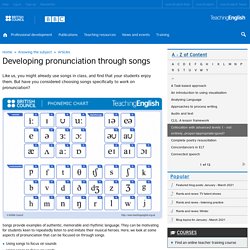
Site. Phonemic chart. Vocabulary activities. Checking Understanding. Analysis of the language consists of two sub-stages, often known as highlighting and concept checking.
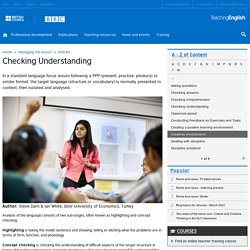
Highlighting is taking the model sentence and showing, telling or eliciting what the problems are in terms of form, function, and phonology. Concept checking is checking the understanding of difficult aspects of the target structure in terms of function and meaning. Concept checking is vital, since learners must fully understand the structure before any intensive practice of form and phonology is carried out. English Grammar reference. TeachingEnglish. English Grammar reference. How to keep your students motivated. Cristina Cabal has been teaching for 26 years. Ways of Motivating EFL/ ESL Students in the Classroom. The word "motivation" is typically defined as the forces that account for the arousal, selection, direction, and continuation of behaviour.
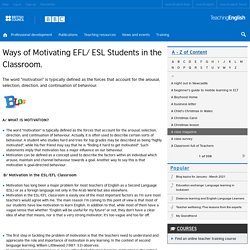
Actually, it is often used to describe certain sorts of behaviour. A student who studies hard and tries for top grades may be described as being "highly motivated", while his/her friend may say that he is "finding it hard to get motivated". Such statements imply that motivation has a major influence on our behaviour. Motivation can be defined as a concept used to describe the factors within an individual which arouse, maintain and channel behaviour towards a goal. Another way to say this is that motivation is goal-directed behaviour. B/ Motivation in the ESL/EFL Classroom. Motivating speaking activities for lower levels. Planning time has been shown to increase production in speaking tasks. Lower level learners often find it especially difficult to speak spontaneously, so these activities incorporate 'thinking time' during which learners can prepare for speaking by planning what they are going to say, and asking the teacher or using a dictionary to look up missing vocabulary.
The following activities are relatively short, with minimal materials preparation time for the teacher. They are designed for use as a warmer or a filler in the middle or at the end of a class. 1. Definitions lists This activity is good for activating existing vocabulary or revising vocabulary studied in previous lessons. Procedure. TeachingEnglish. Carol Read: The secret of working with children. Motivating teenagers. I will link three practical classroom activities to the ideas of American Psychologist Carl Rogers.
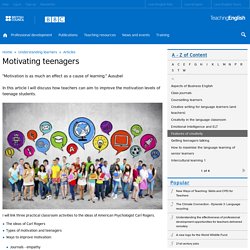
The ideas of Carl Rogers Types of motivation and teenagers Ways to improve motivation:Journals - empathy Using photos - authenticity Music - acceptance. R is for Rapport. As part of my job on the New School MA TESOL program, I’ve been collating evaluations of the last semester’s online courses.

What really stands out are the extremely positive ratings of the teaching faculty: not surprising perhaps, given their collective expertise, but when you consider that the students never actually see their instructors, such positive evaluations are quite remarkable. Here’s a sample: The instructor’s ability to motivate the students was a key ingredient to making this course successful.Great instructor, sensitive, effective with helpful comments throughout the course.
And always available by email if I had a question.This was an excellent course because the professor was extremely involved, helpful and articulate.I cannot praise this instructor enough. TeachingEnglish.
TeachingEnglish. Who needs resources? What type of lessons would this include The following types of lessons would use minimal or no resources, and the students would have to produce most of it using their creative minds and using the teacher as a go-between.
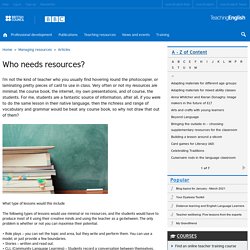
The only problem is whether or not you can maximise their potential. LearnEnglish Kids. TeachingEnglish. Realia in the bag. Every time I use it, I see that all types of students have similar fun in learning new words when the learning involves some suspense.

Adults are usually surprised that they do not know the names of the objects they always use or see. Preparation Find a cloth bag. It should be as big as a school bag and made from normal cloth, not hardened. Collect at least 20 different objects. They can be anything that you can find around you: chalk, duster, stapler, box of staples, match box, ruler, keys, small bottle, shoe brush, tooth brush, paperweight, magnet, board marker, potato, onion, spoon, fork, lime, paper clips, perfume bottle, kettle lid, wooden block, bottle opener, can opener, corkscrew, tin opener, ladle, etc.
Realia. Here are a few suggestions for activities using realia and to consider why we may want to bring things into the class.

Why use realia in class? The main advantage of using real objects in the classroom is to make the learning experience more memorable for the learner. Plenary session by Joy Egbert. About the session Engagement principles and practice in classroom learning, language and technology A still-common issue with technology use in language learning is an overly-strong focus on the digital tools and a relatively weak emphasis on actual learning.

TeachingEnglish. By Teachers, For Teachers... English vocabulary flashcards for kids. Planning 1. This article looks at some general lesson planning questions: What should go into an English language lesson?
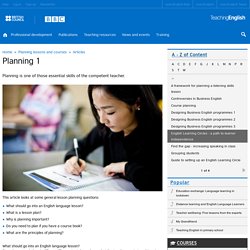
What is a lesson plan? Planning lessons and courses self-study booklet. It forms part of a series of self-study booklets, in which teachers will find useful theory and practice for teaching English effectively, including short case studies and professional development activities to do individually and with colleagues. Featuring a range of engaging and accessible activities, the booklets help teachers to: identify areas for developmentfind a variety of ways to improve their teaching knowledge develop the skills they need in and out of the classroom. Teacher educators can make use of these materials to work with developing teachers to help assess and address their learning needs. Each booklet covers one of the professional practices in the Continuing Professional Development (CPD) Framework for teachers and is based on research into what effective professional development involves.
In this booklet, you will look at: The publications are free to download in pdf format. How to Write a Lesson Plan: 5 Secrets of Writing Fantastic Lesson Plans. Course planning. Pre-service teacher training courses typically focus on the detailed planning of a 40 minute or 60 minute lesson and don’t focus attention on how to go about planning a much longer scheme of work. This is also an important area to consider though, because most teachers are involved in teaching courses, which may typically last anywhere between 30 and 120 hours. The aim of this article is to share some of the conclusions of a recent project I was part of, with the hope that it might enable other teachers to plan a little faster too! Why do we plan our lessons? I think that most teachers plan lessons in order to feel more confident in the class itself.
TeachingEnglish. TeachingEnglish. Katherine Bilsborough: Lesson plans – less is more. TeachingEnglish. Skip to content.